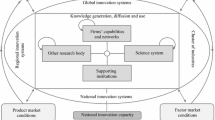Abstract
The Advanced Technology Program (ATP) collected a unique source of data from highly innovative firms beginning in 1993. These data follow the OECD’s guidelines for collecting innovation data and provide important insights for understanding the innovation process within firms. Although the data are not representative of the population of firms, there is sufficient number of firms in the dataset to test hypotheses and to provide a starting point for calls for innovation metrics. Because of the confidential nature of the data, ATP worked with the National Opinion Research Center (NORC) to create a Data Enclave so that researchers could remotely access the ATP data in a secure environment. To initiate the use of ATP data in the Data Enclave, the ATP program funded researchers to undertake research projects that use ATP data. Other organizations have joined the Data Enclave, including the Department of Agriculture and the Kauffman Foundation.

Similar content being viewed by others
Notes
Science of Science & Innovation Policy Newsletter, Volume 1, issue 1, October 2008, http://www.nsf.gov/sbe/scisip/scisipnews1.pdf. Accessed 7 December 2008.
http://www.nsf.gov/statistics/srvyindustry/about/brdis/start.cfm. Accessed 5 December 2008.
The United Nations (2007) prepared a publication Managing Statistical Confidentiality & Microdata Access Principles and Guidelines of Good Practice that describes core principles for researcher access to microdata. The publication also presents twenty case studies that demonstrate that there are a variety of ways to do this. Remote access to microdata is described for Australia, Canada, and Denmark.
Data Enclave, go to: http://www.norc.org/DataEnclave/Datasets/NIST-TIP/.
NORC Data Enclave Newsletter, Volume I, issues 3 and 4, July 2008, http://www.norc.org/NR/rdonlyres/81CDE8EB-438E-4689-A2BB-D2D7211C8E49/0/Newsletter34.pdf.
References
Campbell, S., Chang, C., & Wang, A. (2003). University Participation in the Advanced Technology Program, and Effect on R&D Project Outputs. Proceedings of the American Statistical Association, 2003.
Campbell, S., & Wang, A. (2004). Federal R&D Funding – Outcomes from Award Competition in the Advanced Technology Program. Proceedings of the American Statistical Association, 2004.
Cooper, R. S., & Merrill, S. A. (Eds.). (1997). Industrial Research and Innovation Indicators, Report of a Workshop. Washington, DC: National Academy Press.
Department of Commerce (DOC). (2008). Advisory Committee on Measuring Innovation in the 21st Century. Innovation Measurement: Tracking the State of Innovation in the American Economy.
Dyer, J. H., & Powell, B. C. (2001). Determinants of Success in ATP-Funded R&D Joint Ventures: A Preliminary Analysis Based on 18 Automobile Manufacturing Projects, GCR 00-803. Gaithersburg, MD: National Institute of Standards and Technology.
Dyer, J. H., Powell, B. C., Sakakibara, M., & Wang, A. J. (2006). Determinants of Success in R&D Alliances, NISTIR 7323. Gaithersburg, MD: National Institute of Standards and Technology.
Hall, B. H., Link, A. N., & Scott, J. T. (2002). Universities as Research Partners, NIST GCR 02–829. Gaithersburg, MD: National Institute of Standards and Technology.
Humphrey, C., & Hamilton, E. (2004). “Is it Working? Assessing the Value of the Canadian Data Liberation Initiative.” Bottom Line, Vol. 17 (4), pp. 137–146 and Humphrey, C., in “e-Science and the Life Cycle of Research.” http://datalib.library.ualberta.ca/~humphrey/lifecycle-science060308.doc. Accessed 5 December 2008.
Jaffe, A. B. (2008). The science of science policy: Reflections on the important questions and the challenges they present. Journal of Technology Transfer, 33, 131–139.
Kerwin, J., & Campbell, S. (2007). Findings from the Advanced Technology Program’s Survey of ATP Applicants 2004, GCR 07-908. Gaithersburg, MD: National Institute of Standards and Technology.
Lane, J. (2007). Optimizing the use of micro-data: An overview of the issues. Journal of Official Statistics, 23(3). http://www.jos.nu/Articles/abstract.asp?article=233299. Accessed 7 December 2008.
Lane, J., & Shipp, S. (2007). Using a remote access Data Enclave for data dissemination. The International Journal of Digital Curation, 2(1). http://www.ijdc.net/ijdc/article/view/31/34. Accessed 7 December 2008.
Marburger, J. (2005). Wanted: Better benchmarks. Science, 308(May), 1087.
Marburger, J. (2007). “The Science of Science and Innovation Policy.” Science, Technology and Innovation Indicators in a Changing World, Responding to Policy Needs. Paris, France: OECD Blue Sky II Forum, Organization for Economic Cooperation and Development (OECD).
O’Brien, J., Wang, A., Shipp, S., & McTigue, K. (2006). Findings from the Advanced Technology Program’s Survey of Joint Ventures, GCR 06–889. Gaithersburg, MD: National Institute of Standards and Technology.
OECD. (2005). Oslo Manual: Guidelines for Collecting and Interpreting Innovation Data (3rd ed.). Paris, France: Organization for Economic Cooperation and Development (OECD).
OECD. (2007). Science, Technology, and Innovation in a Changing World: Responding to Policy Needs. Paris, France: OECD Blue Sky II Forum, Organization for Economic Cooperation and Development (OECD).
Office of Science and Technology Policy (OSTP), National Science and Technology Council, Committee on Science, Subcommittee on Social, Behavioral and Economic Sciences. (2008). The Science of Science Policy: A Federal Research Roadmap, November. http://scienceofsciencepolicy.net/uploads/SoSP_Report.pdf. Accessed 7 December 2008.
Petrick, I. J., Echols, A. E., Mohammed, S., & Hedge, J. (2006). Sustainable Collaboration: A Study of the Dynamics of Consortia, GCR 06–888. Gaithersburg, MD: National Institute of Standards and Technology.
Powell, J., & Moris, F. (2004). Different timelines for different technologies. The Journal of Technology Transfer, 29(2), 125–152.
Survey of ATP Applicants 2000. (2003). Portfolio of Survey Factsheets, GCR 03-847. Gaithersburg, MD: National Institute of Standards and Technology.
Survey of ATP Applicants 2002. (2005). Portfolio of Survey Factsheets, GCR 05–876. Gaithersburg, MD: National Institute of Standards and Technology.
Toynebee, A. J. (1961). A Study of History (12 volumes published between 1934 and 1961). http://nobsword.blogspot.com/1993_10_17_nobsword_archive.html. Accessed 7 December 2008.
United Nations. (2007). Managing Statistical Confidentiality & Microdata Access Principles and Guidelines of Good Practice. United Nations Publications, Sales No. E.07.II.E.7, ISBN 13: 987-92-1-116959-1, ISSN: 0069-8458. http://www.unece.org/stats/documents/tfcm/1.e.pdf. Accessed 7 December 2008.
Author information
Authors and Affiliations
Corresponding author
Rights and permissions
About this article
Cite this article
Campbell, S., Shipp, S., Mulcahy, T. et al. Informing public policy on science and innovation: the Advanced Technology Program’s experience. J Technol Transf 34, 304–319 (2009). https://doi.org/10.1007/s10961-008-9098-7
Published:
Issue Date:
DOI: https://doi.org/10.1007/s10961-008-9098-7




